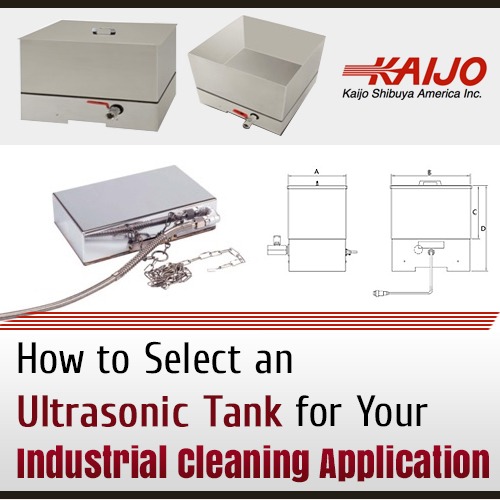How to Select an Ultrasonic Tank for Your Industrial Cleaning Application
October 16, 2018
 Ultrasonic cleaning systems are made up of an ultrasonic generator, one or more transducers and a tank to hold the cleaning solution. The generators and transducers produce the ultrasonic waves responsible for cleaning action, but the ultrasonic tank has to be suitable for the cleaning application as well. In a well-designed system, the ultrasonic frequency, system power and tank characteristics all contribute to optimum performance.
Ultrasonic cleaning systems are made up of an ultrasonic generator, one or more transducers and a tank to hold the cleaning solution. The generators and transducers produce the ultrasonic waves responsible for cleaning action, but the ultrasonic tank has to be suitable for the cleaning application as well. In a well-designed system, the ultrasonic frequency, system power and tank characteristics all contribute to optimum performance.
Size of Tank and System Flexibility
If the ultrasonic cleaning system is a single use installation, the cleaning tank can be sized to exactly contain the parts normally cleaned. For parts that are long and narrow or odd shapes, custom tanks are the most efficient. For ultrasonic cleaning systems that are used for many different cleaning applications, the choice of tank is critical so as to not limit cleaning system flexibility.
If the size of the largest part to be cleaned is known, the tank can be a standard size that will accommodate this part. For delicate parts or for many small parts, a part basket can be used to hold the parts and prevent them from coming into contact with vibrating tank sides and bottom. The tank then has to be slightly larger to hold the parts inside the part basket. If the tank chosen is very large, more than one transducer may be required to make sure cleaning bubbles are generated evenly throughout the cleaning solution.
Types of Transducer
The type of transducer used impacts the design of the ultrasonic cleaning tank. Transducers can be mounted on the tank, bolted onto the tank or be immersible, independent units. Turnkey installations often have mounted transducers and the system can be plugged in, ready to go. Bolt-on transducers are bolted onto the walls or the bottom of the cleaning tank. They are suitable for clearly defined industrial application and several can be bolted onto a tank to ensure complete and rapid cleaning.
Immersible transducers are the most flexible. The transducer is attached to a cable that plugs into the ultrasonic generator and the immersible transducer can be placed in any tank. Possible configurations include vertical or horizontal immersion, the immersion of several transducers and using immersible transducers in existing cleaning tanks.
Special Requirements
While standard ultrasonic cleaning works to remove contaminants and surface dirt quickly and completely, additional measures such as the use of solvents or heat will improve cleaning performance for some applications. Sometimes hard-to-clean deposits of a specific type or hardened grease or rubbery matter can be cleaned more quickly as long as the tanks have a heater and can support a heated cleaning solution
When a contaminant doesn’t easily dissolve in water and is therefore hard to clean in an ultrasonic water bath, the addition of a mild solvent to remove the dirt can speed up the cleaning process. Often a general purpose solvent such as a mild detergent can be used, but for some applications, a solvent specific to the contaminant is best.
Kaijo Ultrasonic Tanks Meet All the Requirements
Kaijo’s ultrasonic cleaning tanks are made from top quality materials and manufactured to the highest standards. They are built to withstand the action of ultrasonic cavitation cleaning bubbles without pitting, are impervious to the solvents that might be used and can hold hot cleaning solutions if required. The tanks are suitable for use with immersible transducers and are available with mounted or bolt-on units.
The company has a complete line of standard ultrasonic cleaning tanks that can be ordered with accessories such as baskets and heaters. For special applications, Kaijo can design and build large or specially shaped tanks and can propose optimum transducer placement, especially if more than one transducer is required. No matter what the cleaning application, Kaijo can propose an ultrasonic cleaning system and make sure it delivers the cleaning performance their customer needs.





